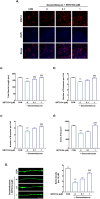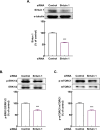SRT2104 enhances dendritic outgrowth and spine formation through Sirtuin 1-mediated mTORC1 signaling
- PMID: 40594837
- PMCID: PMC12216125
- DOI: 10.1038/s41598-025-06203-6
SRT2104 enhances dendritic outgrowth and spine formation through Sirtuin 1-mediated mTORC1 signaling
Abstract
Impaired neuroplasticity is a one of the key pathological mechanism of depression. Sirtuin 1 plays a crucial role in neuroplasticity; however, its precise mechanisms remain unclear. This study examined whether sirtuin 1 regulates dendritic outgrowth and spine formation via mTORC1 signaling in rat primary cortical cells under dexamethasone-induced neurotoxic conditions. Cortical cells were treated with SRT2104 (0.1, 1, and 10 µM), a selective sirtuin 1 activator, in the presence of dexamethasone (500 µM). Protein levels of sirtuin 1, mTORC1 signaling components, and synaptic markers (PSD-95 and GluA1) were analyzed by Western blotting, while dendritic outgrowth and spine density were assessed via immunofluorescence. SRT2104 significantly increased sirtuin 1 expression and ERK1/2 (a downstream target of sirtuin 1) phosphorylation. SRT2104 led to a substantial augmentation in the phosphorylation levels of mTORC1, as well as 4E-BP1 and p70S6K, which are downstream targets of mTORC1. Furthermore, SRT2104 led to an increase in dendritic outgrowth and spine density. Conversely, sirtuin 1 knockdown by siRNA transfection markedly reduced ERK1/2 and mTORC1 phosphorylation, as well as dendritic complexity and spine formation. These results suggest that sirtuin 1 promotes neuroplasticity by activating mTORC1 signaling, providing potential therapeutic implications for depression treatment.
Keywords: Depression; Dexamethasone; Neuroplasticity; SRT2104; Sirtuin 1; mTORC1 signaling.
© 2025. The Author(s).
Conflict of interest statement
Declarations. Competing interests: The authors declare no competing interests. Ethics statement: The animal study was reviewed and approved by Inje Medical College Committee for Animal Experimentation and the Institutional Animal Laboratory Review Board (Approval No. 2023-001).
Figures







Similar articles
-
Establishment of a Depression Model Using Dexamethasone-treated Three-dimensional Cultured Rat Cortical Cells.Clin Psychopharmacol Neurosci. 2025 Aug 31;23(3):418-432. doi: 10.9758/cpn.25.1269. Epub 2025 Mar 10. Clin Psychopharmacol Neurosci. 2025. PMID: 40660688 Free PMC article.
-
Psychosis Risk Candidate ZNF804A Localizes to Synapses and Regulates Neurite Formation and Dendritic Spine Structure.Biol Psychiatry. 2017 Jul 1;82(1):49-61. doi: 10.1016/j.biopsych.2016.08.038. Epub 2016 Sep 15. Biol Psychiatry. 2017. PMID: 27837918 Free PMC article.
-
Saturated phosphatidic acids induce mTORC1-driven integrated stress response contributing to glucolipotoxicity in hepatocytes.Am J Physiol Gastrointest Liver Physiol. 2025 Jun 1;328(6):G663-G676. doi: 10.1152/ajpgi.00027.2025. Epub 2025 Apr 17. Am J Physiol Gastrointest Liver Physiol. 2025. PMID: 40241617 Free PMC article.
-
Drugs for preventing postoperative nausea and vomiting in adults after general anaesthesia: a network meta-analysis.Cochrane Database Syst Rev. 2020 Oct 19;10(10):CD012859. doi: 10.1002/14651858.CD012859.pub2. Cochrane Database Syst Rev. 2020. PMID: 33075160 Free PMC article.
-
Signs and symptoms to determine if a patient presenting in primary care or hospital outpatient settings has COVID-19.Cochrane Database Syst Rev. 2022 May 20;5(5):CD013665. doi: 10.1002/14651858.CD013665.pub3. Cochrane Database Syst Rev. 2022. PMID: 35593186 Free PMC article.
References
-
- Artigas, F. Limitations to enhancing the speed of onset of antidepressants-are rapid action antidepressants possible? Hum. Psychopharmacol.16, 29–36. 10.1002/hup (2001). - PubMed
-
- Malykhin, N. V. & Coupland, N. J. Hippocampal neuroplasticity in major depressive disorder. Neuroscience309, 200–213. http://doi.org/ (2015). - PubMed
MeSH terms
Substances
Grants and funding
LinkOut - more resources
Full Text Sources
Miscellaneous

